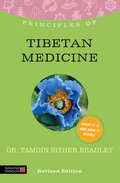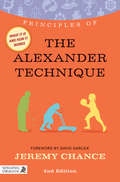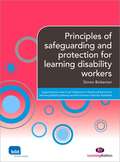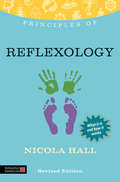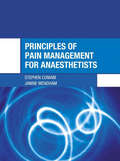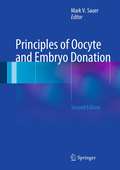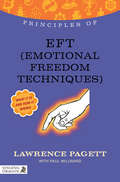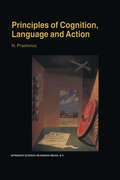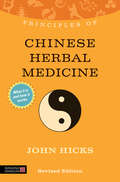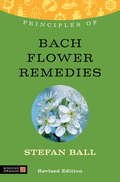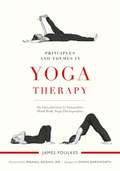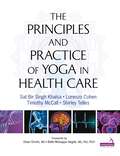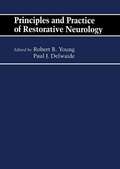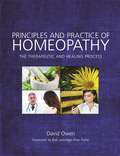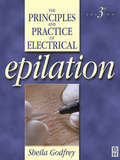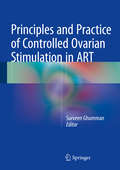- Table View
- List View
Principles of Tibetan Medicine: What it is, how it works, and what it can do for you Revised Edition
by Tamdin Sither BradleyAs people increasingly seek alternatives to modern medicine, interest is growing in the ancient system of Tibetan medicine, which has been practised for over 2,500 years. Known as 'gSo-ba-Rig-pa', or 'the science of healing', it is based on Buddhist philosophical principles, astrology and the close relationship between body and mind. This concise introduction presents all the essential information on Tibetan medicine. It covers the basic theoretical principles, practice and history of this traditional system, as well as methods of diagnosis and treatments such as urine analysis, golden needle therapy and cupping. It includes a chapter on case histories and provides information on what to expect from a practising physician based on compassion. With a comprehensive resources section, this book provides everything there is to know about Tibetan medicine at an introductory level. This book will be of interest to anyone who wants to know more about Tibetan medicine, as well as anyone looking to find out more about Tibetan thought, Tibetan Buddhism, traditional medicine, comparative religion or Eastern spirituality.
Principles of Tibetan Medicine: What it is, how it works, and what it can do for you Revised Edition (PDF)
by Tamdin Sither BradleyAs people increasingly seek alternatives to modern medicine, interest is growing in the ancient system of Tibetan medicine, which has been practised for over 2,500 years. Known as 'gSo-ba-Rig-pa', or 'the science of healing', it is based on Buddhist philosophical principles, astrology and the close relationship between body and mind. This concise introduction presents all the essential information on Tibetan medicine. It covers the basic theoretical principles, practice and history of this traditional system, as well as methods of diagnosis and treatments such as urine analysis, golden needle therapy and cupping. It includes a chapter on case histories and provides information on what to expect from a practising physician based on compassion. With a comprehensive resources section, this book provides everything there is to know about Tibetan medicine at an introductory level. This book will be of interest to anyone who wants to know more about Tibetan medicine, as well as anyone looking to find out more about Tibetan thought, Tibetan Buddhism, traditional medicine, comparative religion or Eastern spirituality.
Principles of the Alexander Technique: What it is, how it works, and what it can do for you Second Edition
by Jeremy ChanceSince its beginnings in Australia in the 1890s, the Alexander Technique has become renowned as a powerful and effective antidote to the stresses and strains that modern life places upon our bodies. This introductory guide presents readers with a definitive overview of the Alexander technique which teaches us how to co-ordinate mind and body effectively so that our thinking is clarified and our movements become naturally lighter. Encompassing everything from teaching lineages to how the method works to how to find a practitioner, the book provides all the key information on the topic. It also includes a chapter on how to practise the technique at home as well as a useful resources section. Written in an engaging style and full of illustrations and photographs that demonstrate the technique, this book will be of interest to anyone considering options for treatment, as well as anyone wanting to know more about the Alexander Technique.
Principles of the Alexander Technique: What it is, how it works, and what it can do for you Second Edition (PDF)
by Jeremy ChanceSince its beginnings in Australia in the 1890s, the Alexander Technique has become renowned as a powerful and effective antidote to the stresses and strains that modern life places upon our bodies. This introductory guide presents readers with a definitive overview of the Alexander technique which teaches us how to co-ordinate mind and body effectively so that our thinking is clarified and our movements become naturally lighter. Encompassing everything from teaching lineages to how the method works to how to find a practitioner, the book provides all the key information on the topic. It also includes a chapter on how to practise the technique at home as well as a useful resources section. Written in an engaging style and full of illustrations and photographs that demonstrate the technique, this book will be of interest to anyone considering options for treatment, as well as anyone wanting to know more about the Alexander Technique.
Principles of Safeguarding and Protection for Learning Disability Workers (PDF)
by Simon BickertonIf you are working within the learning disability sector and studying for the QCF Diploma in Health and Social Care, you will find this book invaluable in helping you to achieve the unit on Principles of Safeguarding and Protection. You will learn how to recognise and respond to signs of abuse and how to reduce the likelihood of it happening. The book is easy to navigate, with each chapter covering one of the learning outcomes within the unit. Each chapter begins with an example taken from real people's stories and lots of activities, photographs and other illustrations are included throughout.
Principles of Reflexology: What it is, how it works, and what it can do for you Revised Edition
by Nicola HallReflexology is a form of complete healing that can detect and correct energy imbalance and restore balance to the body by relating each zone of the body to different points on the hands and feet. This introductory guide covers the theory on which reflexology is based, as well as its history, and the principles of practice. The author includes an description of how treatment works and how it is given, a guide to the reflex areas and their relationship to the rest of the body, effective reflexology treatments and case studies, reflexology as a preventative therapy and how to find a reliable reflexologist. This will be an enlightening guide for anybody interested in what reflexology has to offer and for those wanting to learn more about therapies that present alternatives to traditional treatment. Students and practitioners of reflexology and related practices will find it a useful reference, and a perfect introduction to recommend to clients.
Principles of Reflexology: What it is, how it works, and what it can do for you Revised Edition (PDF)
by Nicola HallReflexology is a form of complete healing that can detect and correct energy imbalance and restore balance to the body by relating each zone of the body to different points on the hands and feet. This introductory guide covers the theory on which reflexology is based, as well as its history, and the principles of practice. The author includes an description of how treatment works and how it is given, a guide to the reflex areas and their relationship to the rest of the body, effective reflexology treatments and case studies, reflexology as a preventative therapy and how to find a reliable reflexologist. This will be an enlightening guide for anybody interested in what reflexology has to offer and for those wanting to learn more about therapies that present alternatives to traditional treatment. Students and practitioners of reflexology and related practices will find it a useful reference, and a perfect introduction to recommend to clients.
Principles of Pain Management for Anaesthetists
by Stephen ConiamPain management is becoming a substantial part of the everyday work of the anaesthetist, and all trainee anaesthetists need a thorough grounding in the basic principles as well as developing the practical skills in order to assess, diagnose, and treat all kinds of pain.Principles of Pain Management for Anaesthetists provides a comprehensive groundi
Principles of Oocyte and Embryo Donation
by Mark V. SauerThe versatility of oocyte and embryo donation has proven to be extremely valuable to both patients and doctors engaged in reproductive medicine. Originally thought to be applicable only to a rather small subset of infertile women, today busy practices commonly recommend the procedure and it is estimated that nearly all of the 400 or more IVF programs in the United States provide these services. Oocyte and embryo donation has established itself as a mainstay procedure within assisted reproductive care, and the breadth, depth and complexity of practice is deserving of focused attention. Much has changed within the field of oocyte and embryo donation since the publication of the first edition of Principles of Oocyte and Embryo Donation in 1998, thus the need for a completely updated and more expansive text. The second edition of this book provides an overview of the major issues affecting men and women engaged in the practice of oocyte and embryo donation. A primary emphasis has been placed on defining the standards of practice that have evolved over the past 30 years, clearly stating the outcomes expected from adhering to these established protocols. Details of both the basic science and the clinical medicine are presented together and attention is also focused on the non-reproductive aspects inherent to this unique method of assisted reproduction that involves opinions from lawyers, ethicists, mental health care professionals and theologians. Oocyte and embryo donation requires a working knowledge of the medicine, the law and the ethics that underlies its foundation. This book is intended to serve as a complete and comprehensive reference for all health care professionals that provide services related to egg donation, reproductive endocrinologists, obstetrician- gynecologists, and fellows and residents entering the fertility field.
Principles of EFT (Emotional Freedom Technique): What it is, how it works, and what it can do for you
by Paul Millward Lawrence PagettThis is the definitive introductory guide to Emotional Freedom Techniques (EFT), a therapeutic psychological tool that draws on Chinese medicine and NLP (Neurolinguistic Programming) to remove blockages within the energy system. Traditional and modern approaches of EFT are explained alongside a comprehensive description of EnergyEFT, the most advanced and evolved form. Simple practical usages of EFT for stress reduction are included, with step-by-step instruction on how to use tapping to remove stress and energise yourself. There are case studies and practical examples demonstrating how EFT can relieve a wide range of negative emotional conditions including anxiety, anger, depression, insomnia and migraines. The book also explores how EFT can improve and maximise positive emotional and spiritual functioning in terms of health and wealth transformation. The uses of EFT are numerous and this handbook is an ideal starting point for anyone interested in learning more about the positive impact EFT techniques can have on their wellbeing.
Principles of EFT (Emotional Freedom Technique): What it is, how it works, and what it can do for you (PDF)
by Lawrence Pagett Paul MillwardThis is the definitive introductory guide to Emotional Freedom Techniques (EFT), a therapeutic psychological tool that draws on Chinese medicine and NLP (Neurolinguistic Programming) to remove blockages within the energy system. Traditional and modern approaches of EFT are explained alongside a comprehensive description of EnergyEFT, the most advanced and evolved form. Simple practical usages of EFT for stress reduction are included, with step-by-step instruction on how to use tapping to remove stress and energise yourself. There are case studies and practical examples demonstrating how EFT can relieve a wide range of negative emotional conditions including anxiety, anger, depression, insomnia and migraines. The book also explores how EFT can improve and maximise positive emotional and spiritual functioning in terms of health and wealth transformation. The uses of EFT are numerous and this handbook is an ideal starting point for anyone interested in learning more about the positive impact EFT techniques can have on their wellbeing.
Principles of Cognition, Language and Action: Essays on the Foundations of a Science of Psychology
by N. PraetoriusThis book addresses a growing concern as to why Psychology, now more than a hundred years after becoming an independent research area, does not yet meet the basic requirements of a scientific discipline on a par with other sciences such as physics and biology. These requirements include: agree ment on definition and delimitation of the range of features and properties of the phenomena or subject matter to be investigated; secondly, the development of concepts and methods which unambiguously specify the phenomena and systematic investigation of their features and properties. A third equally important requirement, implicit in the first two, is exclusion from enquiry of all other mattes with which the discipline is not concerned. To these requirements must then be added the development of basic assumptions about the nature of what is under investigation, and of principles to account for its properties and to serve as a guide as to what are relevant questions to ask and theories to develop about them.
Principles of Chinese Herbal Medicine: What it is, how it works, and what it can do for you Revised Edition
by John HicksChinese herbal medicine has become an increasingly popular method of treatment for a range of different health conditions - from eczema to fertility problems. This book presents an authoritative introduction to the fundamentals of Chinese herbal medicine. Covering everything from the history to the most important Chinese herbs and their properties to what to expect from a consultation, the book provides readers with all the key information about the theory and practice of this medical system. It offers advice on how to find a herbalist as well as providing tips on how to improve overall wellbeing. The book also includes patient stories that demonstrate the effectiveness of Chinese herbs when correctly prescribed. A definitive guide to the essentials of this method of treatment, this book is the perfect starting point for anyone wishing to learn about Chinese herbal medicine, whether for personal use or general interest.
Principles of Chinese Herbal Medicine: What it is, how it works, and what it can do for you Revised Edition (PDF)
by John HicksChinese herbal medicine has become an increasingly popular method of treatment for a range of different health conditions - from eczema to fertility problems. This book presents an authoritative introduction to the fundamentals of Chinese herbal medicine. Covering everything from the history to the most important Chinese herbs and their properties to what to expect from a consultation, the book provides readers with all the key information about the theory and practice of this medical system. It offers advice on how to find a herbalist as well as providing tips on how to improve overall wellbeing. The book also includes patient stories that demonstrate the effectiveness of Chinese herbs when correctly prescribed. A definitive guide to the essentials of this method of treatment, this book is the perfect starting point for anyone wishing to learn about Chinese herbal medicine, whether for personal use or general interest.
Principles of Bach Flower Remedies: What it is, how it works, and what it can do for you
by Stefan BallBach flower remedies are natural medicines derived from flowers that have the power to bring balance back into our lives. This concise introduction is designed to help you start using the remedies for yourself. The book covers the nature and history of Dr Bach's famous system, with many case histories and examples to illustrate how it works. A complete list of remedies is included, along with useful information about how they are made, and a full description of the emotional states that they can help. There are also clear instructions describing how to select and take remedies as well as information on finding a good practitioner. This practical and accessible guide is ideal for anyone interested in using Bach remedies. Students and practitioners will also find it to be a useful reference, and a perfect introduction to recommend to clients.
Principles of Bach Flower Remedies: What it is, how it works, and what it can do for you (PDF)
by Stefan BallBach flower remedies are natural medicines derived from flowers that have the power to bring balance back into our lives. This concise introduction is designed to help you start using the remedies for yourself. The book covers the nature and history of Dr Bach's famous system, with many case histories and examples to illustrate how it works. A complete list of remedies is included, along with useful information about how they are made, and a full description of the emotional states that they can help. There are also clear instructions describing how to select and take remedies as well as information on finding a good practitioner. This practical and accessible guide is ideal for anyone interested in using Bach remedies. Students and practitioners will also find it to be a useful reference, and a perfect introduction to recommend to clients.
Principles and Themes in Yoga Therapy: An Introduction to Integrative Mind/Body Yoga Therapeutics (PDF)
by James Foulkes Mikhail Kogan Simon BarkworthYoga has become increasingly popular in mainstream culture, with varied interpretations of how it should be taught and practiced, and increased awareness of its beneficial effects as a healing modality. As a result, yoga therapy has emerged as an effective alternative approach to health and wellness. Explaining the principles and underpinning ideas presented by the yoga therapy movement, James Foulkes identifies the methods leading to the most effective practice.
Principles and Themes in Yoga Therapy: An Introduction to Integrative Mind/Body Yoga Therapeutics
by James Foulkes Mikhail Kogan Simon BarkworthYoga has become increasingly popular in mainstream culture, with varied interpretations of how it should be taught and practiced, and increased awareness of its beneficial effects as a healing modality. As a result, yoga therapy has emerged as an effective alternative approach to health and wellness. Explaining the principles and underpinning ideas presented by the yoga therapy movement, James Foulkes identifies the methods leading to the most effective practice. Applying a principles-based approach, he explores the concept of delivering yoga therapeutically and discusses more complete ways of thinking about anatomy and the wholeness of the human being, using theories, illustrations, and case studies. Yoga therapy practitioners will learn to improve their work and more effectively support their clients.
Principles and Practice of Yoga in Health Care
by Sat Bir Khalsa Lorenzo Cohen Timothy McCall Shirley TellesThe Principles and Practice of Yoga in Health Care is a professional-level textbook with contributions by multiple expert researchers and therapists in the field.This book brings together the science and the practice of yoga therapysupports the emergence of yoga therapy as a credible professioncomprehensively summarizes research findings and their practical implications for professionals who use yoga or refer patients for yoga practiceincludes chapter contributions by leading biomedical researchers of yogareviews the scientific evidence base for yoga for a wide variety of medical conditionsProvides brief contributions by expert yoga therapists describing practical implementation issues relevant to yoga for specific conditions.The editors include three eminent yoga therapy researchers and one renowned practitioner in the field. They have brought together an experienced team of researchers and yoga therapist contributors.Contents:Section 1: Introduction to Yoga and Yoga Therapy1. Introduction to yoga in health care2. History, philosophy and practice of yoga3. History, philosophy and practice of yoga therapy4. Research on the psychophysiology of yogaSection 2: Mental Health Conditions5. Yoga therapy for depression6. Yoga therapy for anxiety7. Yoga therapy for other mental health conditionsSection 3: Musculoskeletal and Neurological Conditions8. Yoga therapy for back conditions9. Yoga therapy for musculoskeletal and neuromuscular conditions10. Yoga therapy for neurological and immune conditionsSection 4: Endocrine Conditions11. Yoga therapy for diabetes12. Yoga therapy for metabolic syndrome and weight controlSection 5: Cardiorespiratory Conditions13. Yoga therapy for heart disease14. Yoga therapy for hypertension15. Yoga therapy for respiratory conditionsSection 6: Cancer16. Yoga therapy during cancer treatment17. Yoga therapy for cancer survivorsSection 7: Special Populations18. Yoga therapy for pediatrics19. Yoga therapy for geriatrics20. Yoga therapy for obstetrics and gynaecology21. Yoga as prevention and wellnessSection 8: Practical and Future Considerations22. Implementation of yoga therapy23. Future directions in research and clinical care
Principles and Practice of Restorative Neurology: Butterworths International Medical Reviews
by Robert R. Young Paul J. DelwaidePrinciples and Practice of Restorative Neurology is a collection of topics in clinical neurology where progress through research has brought concepts of patient management. The collection emphasizes research done clinically and in experimental laboratories and attempts to discuss restorative neurology in the larger context, encompassing biology, neurobiology, and rehabilitative engineering. The book discusses the concept that neurology should be more therapeutic instead of being just diagnostic because of advances in techniques and drugs. An epidemiology of disability and the evaluation of restorative neurology are explained. The text also presents the developments in the pharmacotherapy of major neurological disorders, such as Parkinson's disease, dementia, and stroke. The use of biomechanical or rehabilitation engineering to treat impaired or lost functions in a patient is compared; the feedback mechanisms and the kinds of treatment including microsurgery, nuerostimulation methods, surgery, and molecular genetics that are applied to specific disorders are discussed extensively. The book also reviews the approaches of gene correction for disorders in the central nervous system. Finally, the future needs of neurology in terms of diagnosis and treatments are dealt with as more research, techniques, and drugs are being discovered and proved useful. The collection is intended for neurologists, neurologists in training, and other physicians whose work lies with neurological disorders. The book can also prove useful for practitioners and academicians in the fields of neurosurgery, internal medicine, psychiatry, and rehabilitation medicine.
Principles and Practice of Homeopathy: The Therapeutic and Healing Process (PDF)
by Bob Leckridge David Owen Peter FisherThis comprehensive textbook provides a detailed, practical and thorough basis for the understanding and application of the homeopathic process. Drawing on the experience and knowledge of a wealth of contributors, the book offers the foundations for the safe and broadest practice of modern homeopathy. Divided into 6 sections, this book takes the understanding of homeopathy from basic principles to the treatment of acute and chronic illnesses, the first prescription, and difficult, confused and hidden cases. Each section progresses through five themes broadly divided into philosophy, material medica, case taking, case analyses and case management. Each theme is woven together through the text and, section by section, builds into an essential study guide for the homeopathic student. It provides opportunities for reflection, and invites all practitioners to engage in their own personal and professional development.
Principles and Practice of Homeopathy: The Therapeutic and Healing Process
by David Owen Peter Fisher Bob LeckridgeThis comprehensive textbook provides a detailed, practical and thorough basis for the understanding and application of the homeopathic process. Drawing on the experience and knowledge of a wealth of contributors, the book offers the foundations for the safe and broadest practice of modern homeopathy. Divided into 6 sections, this book takes the understanding of homeopathy from basic principles to the treatment of acute and chronic illnesses, the first prescription, and difficult, confused and hidden cases. Each section progresses through five themes broadly divided into philosophy, material medica, case taking, case analyses and case management. Each theme is woven together through the text and, section by section, builds into an essential study guide for the homeopathic student. It provides opportunities for reflection, and invites all practitioners to engage in their own personal and professional development.
Principles and Practice of Electrical Epilation
by Sheila GodfreyWritten for the practising electrolysist and student 'The Principles and Practice of Electrical Epilation' covers all aspects of electro-epilation and takes into account recent changes and advances in training and technology during the past decade. This new edition brings these changes into focus. Topics covered in the third edition of this book include: * improved standards of training * the Blend technique of electro-epilation * the development of pre-sterilized disposable needles * training * health and safety at work.A knowledge of endocrinology, the structure and growth cycle of hair, the skin, hygiene, electricity and basic first aid is essential to an understanding of why hair growth occurs, and this problem - which causes distress to very many people - can be treated both safely and efficiently. The book covers all these topics, and also gives advance on how to set up your own practice.
Principles and Practice of Electrical Epilation
by Sheila GodfreyWritten for the practising electrolysist and student 'The Principles and Practice of Electrical Epilation' covers all aspects of electro-epilation and takes into account recent changes and advances in training and technology during the past decade. This new edition brings these changes into focus. Topics covered in the third edition of this book include: * improved standards of training * the Blend technique of electro-epilation * the development of pre-sterilized disposable needles * training * health and safety at work.A knowledge of endocrinology, the structure and growth cycle of hair, the skin, hygiene, electricity and basic first aid is essential to an understanding of why hair growth occurs, and this problem - which causes distress to very many people - can be treated both safely and efficiently. The book covers all these topics, and also gives advance on how to set up your own practice.
Principles and Practice of Controlled Ovarian Stimulation in ART: Principles And Practice
by Surveen GhummanThis book is on ovulation induction and controlled ovarian stimulation which is an integral part of most infertility therapies like intrauterine insemination and in vitro fertilization. It would deal with causes of anovulation and indications for ovarian stimulation. This book deals with basics as well as current and advanced practices. It provides a step by step protocol for ovarian stimulation. It gives a clear understanding of the science of reproductive endocrinology behind these stimulation protocols and roadmaps the latest therapies, defining their current relevance to treatment. Besides the practical guidance it also covers latest research work done in this field. In this day of information overload it is an attempt to integrate relevant information in a manner which can be applied in infertility practice in evidence based manner, making it rational, logical and rewarding for the reader.
